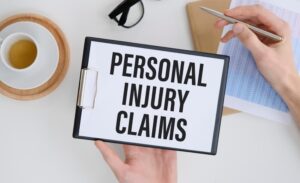In an era defined by convenience and accessibility, rideshare services like Uber and Lyft have become integral to our daily lives. The undeniable ease of summoning a ride at the tap of a screen, however, comes with an alarming uptick in Uber or Lyft car accidents involving these platforms. As the frequency of rideshare-related incidents continues to rise, so does the urgency for individuals to know what steps to take after such accidents. Our experienced rideshare accident lawyers are committed to securing justice and compensation for those affected by ride-related incidents. In this post, we delve into the escalating challenges posed by the surge in Uber and Lyft accidents. We'll explore the complexities surrounding liability, the pivotal role of gathering evidence, and the nuances of navigating insurance coverage. Understanding what to do after a rideshare accident is not just practical—it's a necessity.
Understanding Liability and Negligence in an Uber or Lyft Car Accident
After a rideshare accident, you must identify the responsible party to pursue a legal claim.Identifying Liability
Liability in Uber or Lyft accidents may extend beyond just the driver involved. Potential parties at fault could include the driver, the rideshare company, or even third parties. Navigating the intricate web of liability can build a strong case and hold all responsible parties accountable for the accident. Here's a concise breakdown:- Driver Liability: You can hold Uber and Lyft drivers liable for accidents caused by their negligence, such as reckless driving or distracted behavior.
- Rideshare Company Liability: Uber and Lyft may share liability, especially if the accident occurred during the course of providing a ride. The companies may need to pay for their drivers' actions.
- Third-Party Liability: Other motorists, pedestrians, or entities may also share liability if their actions contributed to the accident.
Establishing Negligence
Lawyers scrutinize factors such as driver behavior, vehicle maintenance, and adherence to traffic laws to establish negligence. Lawyers assess negligence by examining factors like driver conduct, adherence to traffic laws, and overall duty of care. You must gather evidence to establish fault.- Driver Negligence: Negligence by the rideshare driver may include actions like distracted driving, speeding, or violating traffic rules. If the driver fails to uphold a reasonable standard of care, they may be deemed negligent.
- Rideshare Company's Duty of Care: Uber and Lyft have a duty to ensure the safety of their services. If the company neglects proper vetting of drivers, maintenance of vehicles, or fails to address safety concerns, you can hold them accountable.
- Establishing Negligence: Lawyers examine evidence such as eyewitness accounts, accident reports, and electronic data from the rideshare app to establish negligence. You must prove the responsible party breached their duty of care in these cases.
- Contributory Negligence: In some cases, multiple parties may share negligence. Comparative negligence laws come into play, allowing for a determination of each party's degree of fault.
How Insurance Coverage Works for Uber and Lyft
Rideshare companies like Uber and Lyft typically provide insurance coverage that varies depending on the driver's status. Here's a general overview of the insurance coverage for each scenario:App On, No Passenger
Uber and Lyft typically provide basic liability coverage for third-party injuries and property damage during this phase. Coverage limits can vary, but they often start around $50,000 for bodily injury per person, $100,000 for bodily injury per accident, and $25,000 for property damage.En Route to Pick Up or with Passenger
During this phase, the coverage increases significantly to include liability, collision, and comprehensive insurance. Coverage limits are notably higher, often reaching $1 million for third-party liability, with additional coverage for the driver's vehicle.Personal Auto Insurance
While the rideshare app is off, the driver's personal insurance is the primary coverage. Some insurance providers offer additional coverage options or endorsements to bridge the gap during periods when the driver is available but hasn't accepted a ride. It's important to note that these figures can vary, and specific details may depend on the rideshare company's insurance policies and state regulations.Filing a Personal Injury Claim for a Rideshare Crash
Experienced car accident attorneys can provide valuable insights into the strength of your Uber or Lyft accident claim. A personal injury lawyer can identify potential liability and provide guidance to file a personal injury lawsuit, wrongful death claim, or a lawsuit. Work with your attorney to collect evidence supporting your case, including accident reports, witness statements, medical records, and any available electronic data from the rideshare app.
Your lawyer will examine the evidence to determine the parties at fault, which may include the rideshare driver, the rideshare company, or other negligent parties. The goal is to clearly establish the basis for liability.
Before filing a lawsuit, your attorney may negotiate with the rideshare company and insurers to reach a settlement. This step can resolve the matter without going to court.
If negotiations do not succeed, your attorney will file a lawsuit on your behalf. This involves submitting a complaint outlining the details of the accident, the damages incurred, and the legal grounds for the claim.
Both parties exchange information and evidence through the discovery process, which may include depositions, requests for documents, and interrogatories. Parties may continue negotiations for a settlement during the discovery phase. If a fair agreement is reached, the case can be resolved without going to trial. If not, preparations for the trial will begin.
The statute of limitations for personal injury lawsuits varies by state. In Texas, it's typically two years after the accident. Laws and procedures can vary, so consult a Texas attorney familiar with the relevant jurisdiction to ensure compliance with local regulations and deadlines.
Initiating a lawsuit for an Uber or Lyft car accident demands a strategic and timely approach. Working closely with an attorney will guide you through each step, ensuring that you meet crucial deadlines and present a compelling case for fair compensation.
Work with your attorney to collect evidence supporting your case, including accident reports, witness statements, medical records, and any available electronic data from the rideshare app.
Your lawyer will examine the evidence to determine the parties at fault, which may include the rideshare driver, the rideshare company, or other negligent parties. The goal is to clearly establish the basis for liability.
Before filing a lawsuit, your attorney may negotiate with the rideshare company and insurers to reach a settlement. This step can resolve the matter without going to court.
If negotiations do not succeed, your attorney will file a lawsuit on your behalf. This involves submitting a complaint outlining the details of the accident, the damages incurred, and the legal grounds for the claim.
Both parties exchange information and evidence through the discovery process, which may include depositions, requests for documents, and interrogatories. Parties may continue negotiations for a settlement during the discovery phase. If a fair agreement is reached, the case can be resolved without going to trial. If not, preparations for the trial will begin.
The statute of limitations for personal injury lawsuits varies by state. In Texas, it's typically two years after the accident. Laws and procedures can vary, so consult a Texas attorney familiar with the relevant jurisdiction to ensure compliance with local regulations and deadlines.
Initiating a lawsuit for an Uber or Lyft car accident demands a strategic and timely approach. Working closely with an attorney will guide you through each step, ensuring that you meet crucial deadlines and present a compelling case for fair compensation.
Contact Lorenz & Lorenz Accident & Injury Lawyers PLLC
After an Uber or Lyft accident, secure experienced legal representation.
